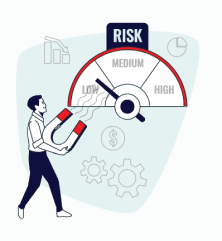Risk management
“We significantly strengthened our risk management and compliance, including closely managing emerging risks, to build the Bank’s overall resilience.”
Deputy CEO cum Chief Risk Officer
Siva R.Krishnan


Overview
Risk Management Division (RMD) operates with an optimal balance of independence and internal business support to help Techcombank achieve its strategic objectives. With accelerated investments, we have been able to:
2022 Highlight
Credit risk management
We set out to design and digitalise a new credit operating model.
The initiative involved:
- Revised credit models
- New automation features, including streamlining documentation
- Risk based profiling for checklist completion
- Underwriting resource selection
- Instant decision support for everyone in the business credit value chain
- Full digitalisation of our early warning and underwriting scores
- A new post-monitoring process for the BCDE system.
We also worked toward achieving our strategic goal of diversifying the Bank’s lending portfolios. Our ‘Smart credit’ retail loan origination platform went live across the country for all secured and unsecured products.
Liquidity risk management
We launched an advanced asset and liability management (ALM) platform, offered by a global leader in risk data and software
Market and interest rate risk in
the banking book (IRRBB)
Advanced measurement of IRRBB
In 2022 we achieved holistic IRRBB management by:
- Introducing banking book yield curve methodology for better measuring the market/fair value of different assets/liabilities
- Measuring, piloting and monitoring Delta Economic Value of Equity (EVE) with a CASA behavioural model, for better assessing our interest rate risk tolerance
- Building a solid methodology to measure and monitor interest basis risk.
Managing market and counterparty credit risks
We deployed aggregated Value at Risk (VaR) for monitoring market risk appetite limits and standardising our risk modelling process

Operational risk management
During 2022, our focus on risk management framework was strengthened and operations modified to address risks from changing ecosystems and make it safer to improve our existing offerings and introduce new products and services.
Data and model
risk management framework
To this end, 2022 saw us solidify the foundations of our data and model risk management framework. This included:
- Strengthening our regulations for data governance Stronger model risk management
- Stronger model risk management regulations
- New standards for model risk governance
- Model inventory and tiering
- Regular monitoring of the quality of model outputs
- An independent review and validation model – we have different levels of validation for over 30 models (initial validation, revalidation and model change validation).
Internal Capital Adequacy
Assessment Process (ICAAP)

As part of our annual solvency stress testing, we applied satellite models synchronised with International Financial Reporting Standards (IFRS) 9 models

The focus of RMD for 2023
With various external headwinds, and their associated business impacts, firmly in mind, 2023 will see RMD focus on building the Bank’s overall resilience.
- We will continue strengthening the risk governance framework, risk functions and associated internal committees and focus groups. This will meet the demands of our stakeholders for comprehensive oversights and enhanced decision making across the ‘three lines of defence’ model.
- ALM risk management capabilities will be bolstered through continuous model enhancements, efficient frameworks such as Internal Liquidity Adequacy Assessment Process (ILAAP) and improving underlying systems and processes. Our balance sheet will be optimised through cyclic stress testing and resilience assurance initiatives.
- We will comply with all risk management regulations set by the SBV and meet the expectations of other international regulatory and ratings bodies.
- Credit risk governance, infrastructure and operating models will be enhanced to achieve desired de-risking and diversification objectives.
- We will continue to upgrade our technology, operating model, anti-fraud capabilities and governance to support the Bank’s data, digital and AI based initiatives.
- A series of contingency drills and continuous feedback loops will be used to ensure business continues during financial and non-financial shocks.